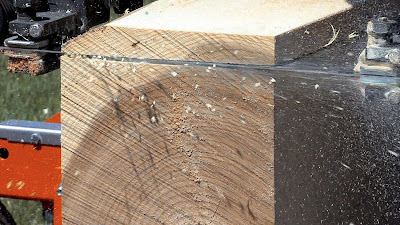.jpg) |
| The Baize Family team. Author Jordan Baize to the far right. |
By Jordan Baize
.jpg) |
| Family photo from 1981 |
In today’s economy, a few years in
business is something to be proud of, not to mention almost 6 decades. Our family’s lumber manufacturing company, B& K Wood Products, is celebrating its 57th anniversary this
April. Companies like ours and Wood-Mizer haven’t just
been lucky over the years or stumbled into good fortunes. Our company has instead formulated a Company
Philosophy for longevity and growth made up of some of the simplest ideas known
to man, and I’d like to share these principles with you. Caution:
this is much simpler than what they teach you in business school! Let’s get started.
Integrity - Establish relationships with
business partners with a handshake and a solid word.
Not many companies can say they are selling to some of the same customers
as they were 40 years ago, but ours can.
There’s no easy, cheap, or quick way of getting customers to buy the
same product from your for more than four decades. There is only one way to accomplish this:
treat your customer with integrity. Look
at the customer-vendor relationship as a marriage. In 40 years, the customer
will have plenty of time to find the faults in you (and there always are a few
faults in all of us). But if you have
treated your customer with integrity for the length of the relationship, they
should care enough about your organization to overlook those faults, or at
least give you time to correct those faults without dropping you first.
.JPG) |
| Milling in 1959 |
Organizations should make it a
point to serve customers, not just push products their way. In the end, the only thing that generates
customer retention is positive relationships that are built on integrity. If the waitress at your favorite pizza joint
is rude and unhelpful, the pizza you once enjoyed will start tasting worse and
worse. No product is good enough to
overcome poor relationships. Integrity
wins in the end every time. Not to
mention it just feels good at the end of the day to be able to hold your head
high. Try it! It’s worked for us.
Diversification - Offer a wide array of products and services.
Our company was started over
50 years ago as a side lumber and crossties operation only. Today, sawmilling is still a big part of what
we do, but it is not the only thing we do. Nor will it ever be again. We have adopted a more diverse range of
products than just the standard lumber and tie variety out of necessity. This has always been a strategic position of
ours, and it proved its worth in 2009.
Countless friends and competitors of ours shut their doors for the last
time that year. At the time, most of
them were still cutting the same side lumber and crossties we were cutting 50
years prior. There is nothing wrong with
consistency, but when times change, we must change with them or risk
looking failure in the face.
Diversifying your products and
services to cover varying areas of the market is a necessity. For instance, during the heart of the
economic crisis when the housing market had tanked, we were not able to sell
much of our inventory that ends up as cabinet facings, hardwood flooring, or
stair treads. Instead, we had to lean
heavily on other products that we produce and divert those revenue streams
(which were quickly drying up) down other avenues. A few years back our wood chip market was
soft so we went looking for another way to capitalize on our wood waste. Because of that diversification, we are now
Kroger’s largest producer of manufactured firewood, a new use for the same
material our wood chips once came.
Whatever It Takes – Manufacture products of unquestionable quality
using both trail-blazing technologies and beaten-path tools of the trade.
Our company has been around
for a while and learned many things over the years. We pride ourselves in not forgetting the many
lessons learned through the decades, all the while not neglecting newer
technologies and good, old-fashion hard work.
We feel like that is simply the only way to be consistently profitable
in business.
When our organization sets up a
production goal, we meet that goal. Period.
Budgets and forecasting are useless if the top number on the income
statement (gross revenue) is lower than expected. Companies must aim to produce quality
products in the expected timeframe.
Anything short of that changes the financial landscape of the
company. Use all resources necessary to
get the job done on time—whatever it takes.
Thrive, Don’t Survive!
 |
| The B&K Wood Products facility |
The simple active application of
these ideals to our business has resulted in longevity spanning 57 years. It’s important to remember that most people
who have been successful have taken a few easy-to-understand principles that
their grandfather could have taught them, and followed them without wavering. Instead of avoiding failure, business owners
and managers should instead be trying to attain greatness and longevity. Thrive, don’t just survive—let’s go the
distance!
For more information on products that have helped B&K succeed, visit woodmizer.com. Also, to see how thin-kerf headrigs can help your business increase profitability, watch this video: Ohio Valley Veneer


.jpg)
.jpg)
.JPG)















